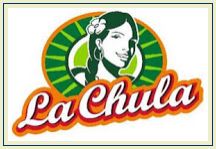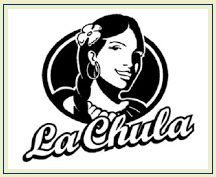The Board reversed a Section 2(d) refusal of the mark LA CHULA & Design (shown immediately below) for "preserved, frozen, dried, and cooked fruits," finding no likelihood of confusion with the registered mark CHULA BRAND, in standard character form, for "fresh fruits and vegetables, namely, citrus, lemons, avocados, coconuts, papayas, pineapples" [BRAND disclaimed]. Although the marks are similar and the goods related, applicant's ownership of a more-than-five-years-old registration for the mark shown second below, for "fruit conserves," was dispositive. In re Daboub and Giner, Serial No. 87351674 (August 28, 2018) [not precedential] (Opinion by Judge Angela Lykos).

The Board found that because the involved marks "share the dominant, arbitrary term LA CHULA [sic], the marks overall are similar in sound, appearance, connotation and commercial impression." This is true even though in the applied-for mark the term "La Chula" is translated as "the beautiful one" or "the show-off," and in the cited registration "Chula" is translated as "sparkling." Evidence of third-party websites showed both applicant's and registrant's products sold under the same mark.
Typically this would suffice to find a likelihood of confusion. However, in some instances, a single du Pont factor may be pivotal, and such is the case here.
The 13th du Pont factor encompasses "any other established fact probative of the effect of use." Though "rarely invoked," it "accommodates the need for flexibility in assessing each unique set of facts." For example, "[w]here an applicant owns a prior registration that is over five years old and the mark is 'substantially the same' as in the applied-for application, this can weigh against finding that there is a likelihood of confusion. In re Inn at St. John's, LLC , 126 USPQ2d 1742, 1748 (TTAB 2018) (citing In re Strategic Partners Inc., 102 USPQ2d at 1399 (no likelihood of confusion found with the registered mark ANYWEAR BY JOSIE NATORI and design where the applicant's previously registered mark ANYWEARS was substantially similar to the applied-for mark ANYWEAR for identical goods))."
Here, applicant owned a more-than-ten-year-old registration for the mark shown below, for "fruit conserves." Under Section 14, that registration is "impervious to a challenge under Section 2(d)."

This prior registration has no claim to color, and so the mark is "not only 'substantially the same' as, but more importantly, legally identical to the applied-for mark." In other words, that prior registration covers the color scheme of the applied-for mark. Thus the applied-for mark does not "move [any] closer" to the mark in the cited registration. Compare In re Inn at St.John's, LLC, 126 USPQ2d at 1748. Moreover, the fruit conserves of the prior registration are highly related to, if not identical with, the goods in the subject application.
The examining attorney, relying on Section 1207.01 of the TMEP, attempted to distinguish Strategic Partners on the ground that there, the cited registration and the applicant's prior registration had co-existed for more than five years, and so both registrations were immune from a Section 2(d) attack. The Board, however, rejected that narrow interpretation of the 13th du Pont factor. In short, "the fact that cited registration is not over five years old is not fatal."
The Board concluded that "even though the first and second du Pont factors weigh in favor of finding a likelihood of confusion, . . . the thirteenth factor outweighs them all, making confusion unlikely."
The content of this article is intended to provide a general guide to the subject matter. Specialist advice should be sought about your specific circumstances.
